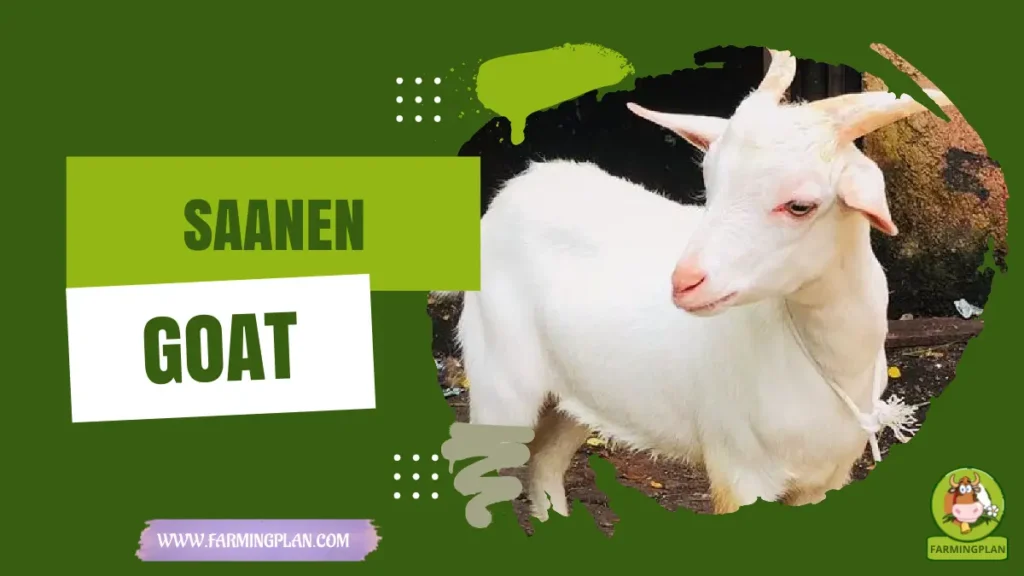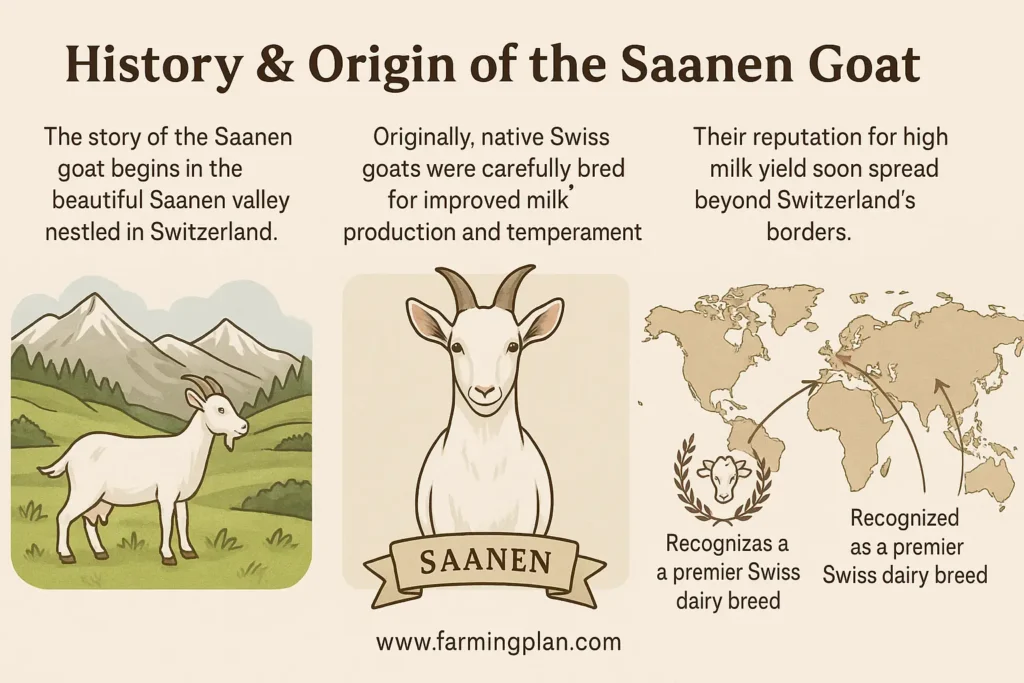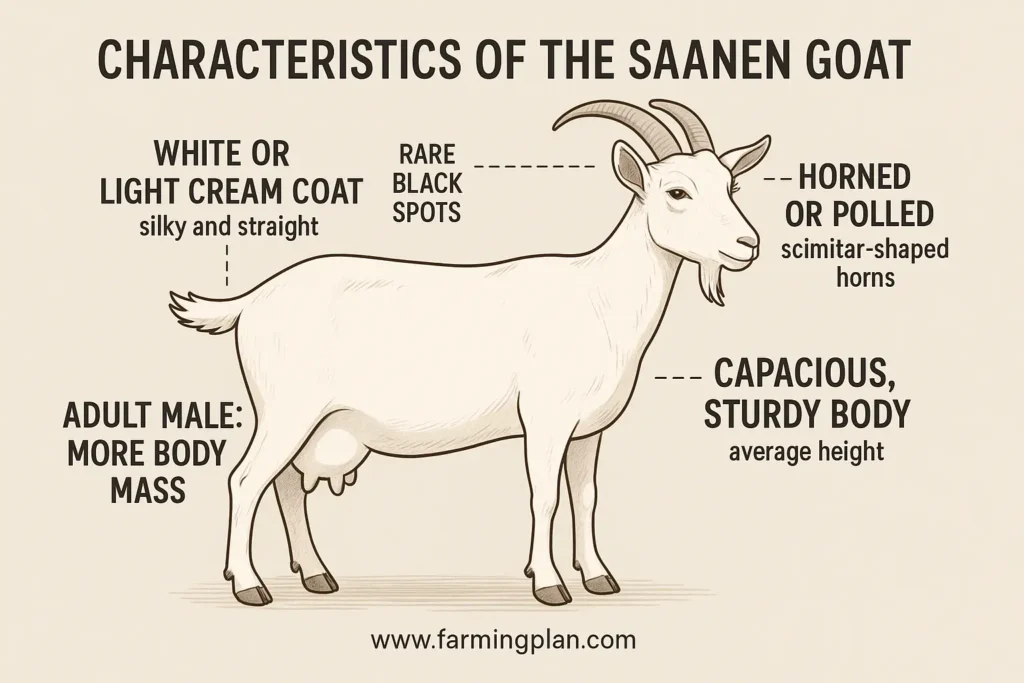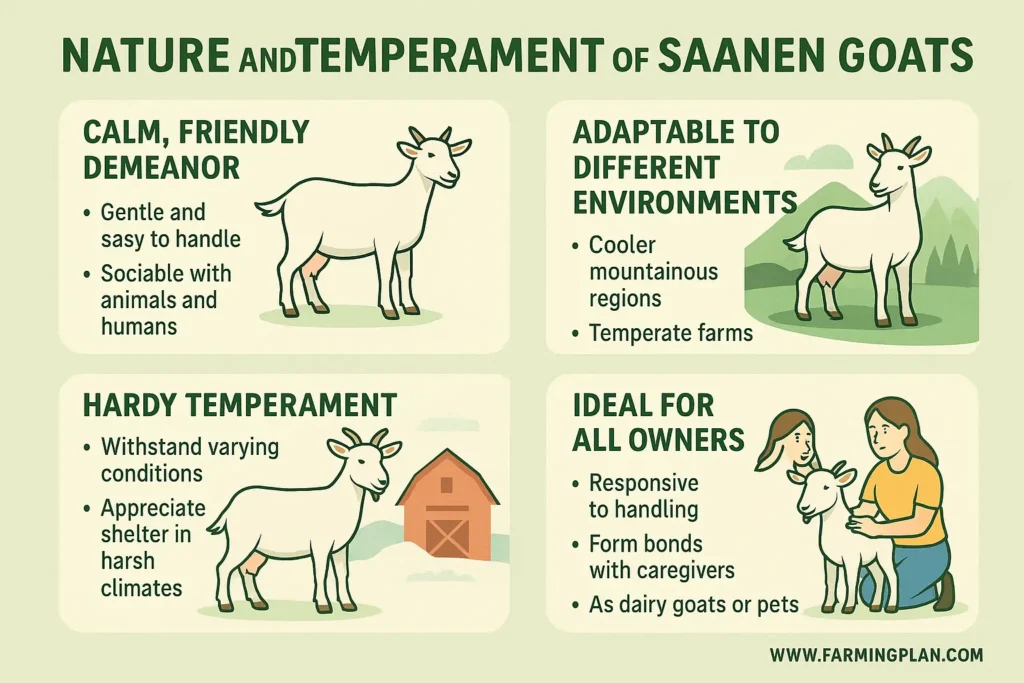If you’re thinking about raising dairy goats or just curious about one of the most popular breeds worldwide, the Saanen goat deserves your attention. Known as the “Holstein of goats,” the Saanen goat stands out because of its impressive milk production, calm nature, and striking white coat. This breed isn’t just a pretty face it’s a reliable workhorse for dairy farmers, hobbyists, and breeders alike. In this article, I’ll walk you through everything from their Swiss roots and unique traits to care tips and common health issues, making it easy to understand and apply whether you’re a seasoned farmer or just getting started. Let’s explore why the Saanen goat is a favorite among goat lovers everywhere.

History & Origin of the Saanen Goat
The story of the Saanen goat begins in the beautiful Saanen valley nestled in Switzerland. This region, with its cool climate and lush pastures, provided the perfect backdrop for the breed to develop. Originally, native Swiss goats in this valley were carefully bred over centuries, focusing on improving milk production and temperament. That long-time selective breeding gave rise to the elegant, all-white Saanen goat known today.

Their reputation for high milk yield soon spread beyond Switzerland’s borders. French-speaking Mediterranean countries and North America welcomed the breed, valuing its adaptability and dairy capabilities. In fact, the American Dairy Goat Association recognizes the Saanen as a premier Swiss dairy breed, prized by farmers across many countries. Over time, breeders have maintained the Saanen’s pure traits while adapting it to various environments, from harsh winters to tropical climates, making it a truly global dairy superstar.
Characteristics of the Saanen Goat
What makes a Saanen goat instantly recognizable? For starters, their smooth white or light cream coat is a classic signature, often silky and straight. While pure white is most common, you might occasionally spot goats with tiny black spots, though these are rare and usually not preferred in breeding programs. These goats have a capacious, sturdy body type with an average height that commands presence without bulkiness. Adult males typically weigh more and have more pronounced body mass compared to females.

Regarding horns, Saanens can be either horned or polled (hornless), but many breeders prefer hornless goats for easier management. When present, the horns tend to be scimitar-shaped or spiral, contributing to their elegant look. British Saanen varieties sometimes show slight variations in color or horn shape, but overall, the breed sticks to its Swiss standards of a light cream or white coat and a well-proportioned frame. This makes them not just functional dairy goats but also visually appealing animals in any herd.
Read More: British Alpine Goat: Meat, Milk & Markings
Nature and Temperament of Saanen Goats
One of the reasons Saanen goats are so beloved is their calm, friendly demeanor. These goats tend to be gentle and easy to handle, which is great news whether you’re a hobbyist or managing a large dairy farm. Their laid-back nature means they’re generally sociable with other animals and humans, making daily chores less stressful. Plus, their adaptability to different environments—from cooler mountainous regions to temperate farms—adds to their appeal.

Saanens are also known for being hardy enough to withstand varying conditions, though they do appreciate shelter in harsh winters or extreme climates. Their temperament makes them ideal for first-time goat owners and experienced breeders alike, as they’re responsive to handling and can form bonds with their caregivers. Whether you want a productive dairy goat or a gentle pet, Saanens check both boxes.
Food and Diet for Saanen Goats
Feeding your Saanen goat well is key to unlocking their dairy potential. These goats thrive on a balanced diet rich in forage like pasture grass and quality hay, which forms the bulk of their nutrition. To boost milk production, supplementing their feed with grains or concentrates is common, but moderation is crucial—overfeeding grains can upset their digestion.
Saanens, like many dairy goats, also benefit from mineral supplements, especially calcium and phosphorus, which support milk production and bone health. One fun fact is that exposure to excessive sunlight can sometimes cause unwanted black spots on their coats, so providing shade during hot days can be a subtle way to keep them looking pristine. Another tip: because Saanens respond to photoperiods (day length), managing their light exposure can influence their reproductive and milk production cycles. In short, a well-planned diet paired with smart environmental care will keep your goats healthy and productive.
Read More: Jakhrana Goat: The Rajasthani Dairy Goats
Usage and Purpose of Saanen Goats
Saanen goats have earned their reputation as top-tier dairy goats for good reason. They produce large quantities of fluid milk that’s prized for its mild flavor and suitability for cheese production. In fact, many cheese makers prefer Saanen milk because of its balanced fat and protein content. While their primary role is dairy production, these goats can also contribute to the goat meat market, though that’s usually secondary.
Farmers value Saanens in breeding programs to improve local dairy goat populations thanks to their reliable milk yield and calm temperament. Additionally, some hobby farmers and breeders keep them for showing or as pets, thanks to their beautiful white coats and gentle disposition. Their versatility makes them a smart choice whether your goal is milk, meat, or just the joy of raising an easygoing goat.
Special Features of Saanen Goats
There are a few standout qualities that set Saanen goats apart. First, their response to the long-day photoperiod is remarkable—they tend to produce more milk when exposed to longer daylight hours, a trait not all goat breeds share. This physiological adaptation involves hormones like melatonin and thyroid-stimulating hormone (TSH), which influence their reproductive and metabolic functions.
Their milk typically contains an excellent balance of fat and protein, making it ideal for cheese production and fluid milk markets alike. Also, the breed’s capacious body and hardy nature mean they maintain vigor in various climates, from the cool Swiss Alps to warmer Mediterranean zones. These goats are a perfect blend of function, beauty, and adaptability, which is why they remain a staple in dairy goat farming worldwide.
Read More: African Pygmy Goat: Adorable, Versatile Farm Animal
Health Issues and Prevention in Saanen Goats
While Saanen goats are generally hardy, they’re not immune to health issues. Infectious arthritis is one common concern, especially in poorly managed herds. Symptoms include swollen joints and lameness, so early detection and veterinary care are critical. Regular vaccinations and parasite control go a long way in prevention.
Another area to watch is genetic health—because the breed is so popular, recessive genes causing disorders of sex development or thyroid hormone imbalances can crop up if breeders aren’t careful. Responsible breeding practices, including genetic testing and avoiding inbreeding, help maintain herd health. Proper housing, clean water, and good nutrition form the foundation of preventive care that keeps your Saanens happy and productive.
“Balanced Nutrition And Happy Goats Make For The Creamiest Milk — And Happiest Farmers!”
Step-by-Step Farming Guide / Pet Owner Care Guide for Saanen Goats
Step 1: Setting Up the Farm Environment
Start with a well-ventilated shelter that protects goats from extreme cold, heat, and excessive sunlight. Saanens do best with plenty of clean space for grazing and exercise. Ensure sturdy fencing to keep predators out and goats in—Saanens are curious and can slip through weak spots. Ground clearance is important to avoid dampness that can lead to foot problems.
Step 2: Selecting Healthy Breeding Stock
Choose goats with smooth, white or cream coats and good body condition. Look for alert eyes, clean noses, and no signs of parasites or illness. Horn status is a personal choice, but hornless goats are often easier to manage. Avoid goats with black spots if purity is important to you.
Step 3: Feeding and Watering Schedules
Provide access to fresh pasture or quality hay daily. Supplement with grains and minerals, especially during milking or pregnancy. Fresh, clean water must be available at all times. Adjust feed based on the goat’s age, condition, and production level to prevent obesity or malnutrition.
Step 4: Milking Routines and Hygiene
Consistency is key—milk at the same time each day, twice daily for best production. Keep milking equipment clean and wash your hands before milking to prevent infections like mastitis. A calm environment helps keep goats relaxed and milk flow steady.
Step 5: Health Monitoring and Preventive Treatments
Regularly check your goats for signs of illness like limping or unusual behavior. Maintain a vaccination schedule and deworm every few months based on your vet’s advice. Trim hooves regularly to prevent foot rot and keep bedding dry and clean.
Step 6: Managing Seasonal Breeding Cycles
Saanens are long-day breeders, so use artificial lighting or adjust breeding times to sync with production goals. Track estrus cycles and maintain detailed records for better herd management.
Step 7: Record-Keeping for Production and Breeding
Keep records of milk yield, breeding dates, health treatments, and offspring details. This information helps you identify high producers and plan future breeding, ensuring your herd stays productive and healthy.
Expert Tips and Best Practices for Raising Saanen Goats
- Always maintain balanced nutrition with plenty of forage and mineral supplements.
- Protect your goats from excessive sunlight to keep their coats pristine.
- Use selective breeding to preserve the capacious body and milk production traits.
- Keep housing clean and dry to prevent infectious diseases.
- Join organizations like the American Dairy Goat Association for resources and breed standards.
FAQ
How much milk does a Saanen goat produce?
On average, a Saanen goat can produce between 2 to 3 liters of milk per day, making them one of the top dairy breeds in the world.
Are Saanen goats easy to handle for beginners?
Yes! Saanens are known for their calm and friendly temperament, which makes them great for first-time goat owners and experienced farmers alike.
What do Saanen goats eat?
Their diet mainly consists of quality pasture or hay, supplemented with grains and minerals to support high milk production.
Do Saanen goats require special housing?
They need clean, dry shelters with good ventilation and protection from extreme weather, but they are quite adaptable to different climates.
Can Saanen goats be kept as pets?
Absolutely! Due to their gentle nature and beautiful white coat, many people keep Saanens as both productive dairy animals and friendly pets.
Conclusion
Raising Saanen goats is a rewarding experience whether you’re aiming for high-quality milk production or simply want a gentle and beautiful addition to your farm. Their Swiss heritage, calm nature, and impressive dairy capabilities make them a favorite worldwide. With proper care—from balanced feeding and secure housing to attentive health management—you can enjoy the benefits of these wonderful goats for years to come. Whether you’re a hobbyist or a seasoned farmer, the Saanen goat offers a reliable, productive, and friendly companion that’s hard to beat in the world of dairy farming.

